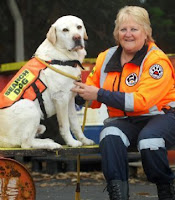 |
| (Australian bushfires are big. Really big. source) |
What an important topic to raise. Its so important that we stop to consider what animals are experiencing in times of natural disaster and rescue.
It got me thinking about a different kind of natural disaster that struck my local community in February 2009, the series of bushfires (wild fires) that came to be known in Australia as the Black Saturday bushfires.
It was horrible.
 |
| One of the formerly forested ridges in the 2009 bushfire zone (source) |
There were many, many, many people, pets, other animals and wildlife who were killed, injured and/or displaced by this huge and devastating event.
But Julie, do you know what? Dogs helped. They really did.
In so many special ways.
 |
| A search and rescue dog and handler (source) |
Volunteer handlers with their search and rescue dogs helped to locate the remains of people who had died trying to defend or take shelter in their homes, enabling identification that would assist with closure for the victims remaining families.
We have evidence about how important the role of dogs and pets can be in our lives. Especially for children. The relationship children form with their pets has been shown to help modulate the effects of traumatic events like natural disasters. So keeping pets with families (or in a safe place that can be visited and where families know they are safe) is an important part of helping people cope in times of disaster.
Just by being present, many dogs were acting as unwitting therapists. Offering the opportunity for calming behaviour - like patting, which has been shown to result in lower blood pressure and heart rate in the person patting the dog - when people really needed it.

The nearest animal shelter to the area devastated was immediately inundated by displaced large animals, cats, dogs, other small pets and numerous wildlife. You can read their account from page 40 of the article in Animal Sheltering magazine here.
 |
| Happy was treated for burns at the shelter & featured in the media (source) |
As the shelter had prepared for the possibility of a fire in the region, they were prepared to some degree. However, they found themselves immediately under pressure to find resources to house, feed and reunite hundreds of small and large animals with families who potentially (and very probably) had no homes left to return to. Within two days the shelter was inundated by offers of support from other vet clinics, community members, volunteers and people WANTING TO HELP THE DOGS (oh, OK, and the other animals!).
 |
| (source) |
A huge network swung into action sourcing and coordinating the donations of cages, blankets, food, etc. etc. from all over the country. This was an incredible feat given many of the shelter staff lived in the affected area or had friends/family affected. It gave the wider community a sense that they were contributing to help in some tangible way (enabling them to COPE on a psychological level with the awful reality) and also helped the affected area feel that people were aware of their situation and there to support them.
So important.
Im pleased to see that your city has similarly been pulling together in the wake of Sandy.
So you see? Dogs help in natural disasters. They really do.
 |
| Sam the koala drinking from a volunteer fire fighters bottle |
I know its not a dog, but this koala (dubbed "Sam") is a really interesting case. Koalas are not usually considered friendly or approachable in the wild. They can hiss and bite and scratch if they are approached and feel threatened.
But this chap offered the entire country watching these horrific events unfold a beautiful moment of hope and wonder. He let a firefighter approach him and drank from his water bottle. An illustration of a positive human-animal connection all forms of media distributed far and wide.
Highly unusual behaviour (as the firefighter acknowledges with some colourful language part way through the video!).
I hope your election day went well over there. I really enjoyed reading your contribution to this piece about Seamus Romneys trip to Canada.
Til next time!
Mia
.jpg) |
| The region transformed in the 2009 bushfires is regenerating. |
Komar D. (1999) The use of cadaver dogs in locating scattered, scavenged human remains: preliminary field test results., Journal of forensic sciences, PMID: 10097372
Yorke J. (2010). The significance of human–animal relationships as modulators of trauma effects in children: a developmental neurobiological perspective, Early Child Development and Care, 180 (5) 559-570. DOI: 10.1080/03004430802181189
Blue G.F. (1986). The Value of Pets in Childrens Lives, Childhood Education, 63 (2) 85-90. DOI: 10.1080/00094056.1986.10521747
Vormbrock J.K. & Grossberg J.M. (1988). Cardiovascular effects of human-pet dog interactions, Journal of Behavioral Medicine, 11 (5) 509-517. DOI: 10.1007/BF00844843
Cherry K.E., Silva J.L. & Marks L.D. (2009). The Psychology Behind Helping and Prosocial Behaviors: An Examination from Intention to Action , Lifespan Perspectives on Natural Disasters, 219-240. DOI: 10.1007/978-1-4419-0393-8_11
Lyons R.F., Mickelson K.D., Sullivan M.J.L. & Coyne J.C. (1998). Coping as a Communal Process, Journal of Social and Personal Relationships, 15 (5) 579-605. DOI: 10.1177/0265407598155001
Irvine L. (2007). Ready or Not: Evacuating an Animal Shelter During a Mock Emergency, Anthrozoos: A Multidisciplinary Journal of The Interactions of People & Animals, 20 (4) 355-364. DOI: 10.2752/089279307X245482
Emergency Animal Welfare Plan (Department of Primary Industries Victoria)
Pets and bushfires (Country Fire Authority, Victoria)

0 komentar:
Posting Komentar